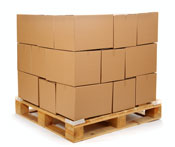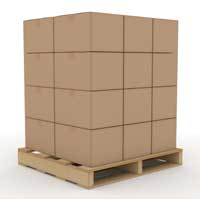Last week we looked at the challenges and some misconceptions about shipping packages in a single-parcel shipping environment. Basically, an individual parcel is subject to huge stress during transit and we discussed several ways to increase its survival odds. (Go Here for the related article.)
Another way to minimize transit damage is to ‘unitize’ your shipment for transport with the carefully planned use of corrugated boxes stacked on pallets and wrapped. In a sense you are turning many individual parcels into one giant parcel. Generally this method is less prone to damage than the small parcel.
The Fiber Box Association is dedicated to the corrugated box industry and in their manual they disclose some surprising statistics regarding factors that significantly affect the strength of your palletized (or unitized) shipments. (There are other methods of unitizing but we’re not covering them here since we don’t normally use them in the printing industry.) I’ve packed a lot of pallets in my time and even though I did what I thought was a good job, I was surprised to learn I made more than my share of basic mistakes.
Storage time under load. Did you know, for instance, that palletized boxes sitting in storage for 10 days can lose up to 37% of their compression strength? At 180 days, it’s 50%.
Relative Humidity (RH). At 50% RH there is no loss of strength. At 100% RH there is an 85% loss. So a shipment that was fine in last week’s good weather may be damaged this week because it spent time in a high-humidity environment. The boxes failed even though the load on them was identical.
Pallet Patterns. The popular interlocked stacking pattern can cause a 40-60% loss of strength whereas the columnar aligned pattern has a 0-8% loss.
Pallet Overhang. If the boxes hang over the edge of the pallet, even as little as 1/2”, you can expect a 20-40% loss of strength.
Pallet Deck Board Gap. Gaps in the pallet deck can cause 10-25% loss of strength. Those gaps mean there is no support underneath that part of the box.
Excessive Handling. You can lose up to 40% here. Simply put, the more you handle the pallets the weaker the boxes become.
I’m also sure that a combination of two or more of the above factors is a surefire way to guarantee failure. There are, however several simple things to watch for to ensure your palletized shipments arrive intact. Although the fixes aren’t exactly rocket science, packaging engineers spent a lot of research time studying and testing to arrive at these recommendations.
- Avoid platform overhang. Stacking boxes with an edge hanging over the side of the pallet is a sure-fire way to cause damage. The strongest parts of the box are the four corners and when 2 are unsupported in an overhang situation, you will almost certainly get carton failure.
- Use the full pallet. If the stack of boxes on the pallet doesn’t use all the pallet deck space available, the stack is more prone to shifting. Shifting causes misalignment of the stack which increases the odds of failure. So maximize your space usage and also be sure to cover any gaps on the pallet deck with a slip sheet made of fiberboard or corrugated.
- Use stretch wrap or other unitizing aids. These are great at keeping the load fixed in place on the pallet. It also prevents moisture and humidity damage. Corner boards, strapping and adhesive can also be used with stretch wrap to stabilize and bullet-proof your pallet.
- Use corrugated inserts or partitions within the box to increase compression strength. Or as we mentioned in last week’s article, pack a box within a box for the ultimate in protection.
- Try changing the box weight or product orientation. You don’t necessarily have to change the box. Change the quantity or the way it’s packaged so that you get maximum pallet coverage and ideal stacking.
 Use Columnar Stacking. Many of us in the bindery were taught that it is stronger to stack boxes in an interlocked fashion. (photo right) Well, that’s not quite accurate. An interlocked stack does indeed help to hold the boxes together but that advantage is offset by the far greater potential for box failure.
Use Columnar Stacking. Many of us in the bindery were taught that it is stronger to stack boxes in an interlocked fashion. (photo right) Well, that’s not quite accurate. An interlocked stack does indeed help to hold the boxes together but that advantage is offset by the far greater potential for box failure.
It is better instead to use columnar stacking (photo lower right) combined with a slip sheet between each layer, or unitizing adhesive to hold the boxes  together. This special adhesive glues each box to the box below. It prevents side-to-side shear but lets you easily unstack the boxes without much effort. An alternative is to use columnar stacking on the bottom units with interlocked boxes on the top layer. Obviously, don’t forget to do a good job of strapping and stretch wrapping to prevent the load from shifting.
together. This special adhesive glues each box to the box below. It prevents side-to-side shear but lets you easily unstack the boxes without much effort. An alternative is to use columnar stacking on the bottom units with interlocked boxes on the top layer. Obviously, don’t forget to do a good job of strapping and stretch wrapping to prevent the load from shifting.
Attention to a few small details in packaging and shipping is the last detail in a long line of details for what might be a complicated printing and binding project. If it arrives scattered all over the back of the truck, you’ll be getting photos and a phone call from your customer. Worse, you’ll be marked as unprofessional and you could face significant reprint and re-bind costs.
If you’re having problems with palletized shipments, take a few minutes to review. The answer could be as simple as those listed above. As always, we welcome your comments, suggestions and stories below!

